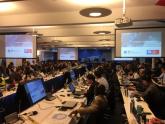Argentina and Chile once again presented the joint proposal for a Marine Protected Area (MPA) for the Western Antarctic Peninsula within the framework of the Commission for the Conservation of Antarctic Marine Living Resources (CCAMLR), whose virtual sessions were held with the participation of diplomats and scientists from the Argentine Foreign Ministry.
Binational work in favor of the MPA has stirred the interest of the international community. In this sense, National Geographic, together with scientists and technicians from the Antarctic Institutes of both countries, made the documentary "The Antarctic Peninsula", which recently premiered.
As a leading player in the Antarctic Treaty system, our country has been a strong promoter of the protection of marine biodiversity in the Antarctic Peninsula area, whose fragile ecosystem suffers the impacts of climate change and also fishing. The area concentrates about 75% of the circumpolar population of krill, an essential food for whales and penguins, and registers the highest human activity in Antarctica, including the numerous national Antarctic and tourism programs that account for some 50,000 visitors per year.
The binational MPA proposal is the result of high-quality scientific work initiated in 2012 by a team of researchers from the Argentine Antarctic Institute and its Chilean counterpart. It was first presented in 2018 and is still in the approval process.
With a virtual format and a reduced agenda due to the pandemic, the 39th meeting of the 26 members of the Commission, whose vice-presidency is held by Argentina, took place between October 26 and 30, with the aim of advancing this and other topics of great interest to the international environmental agenda. Meanwhile, the meeting also contemplated various measures that will allow the rational development of fishing in Antarctic waters and facilitate the control of irregular activity.


